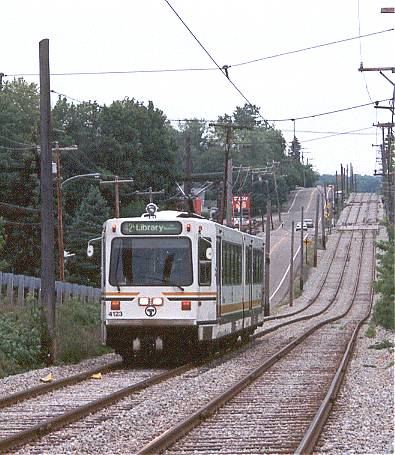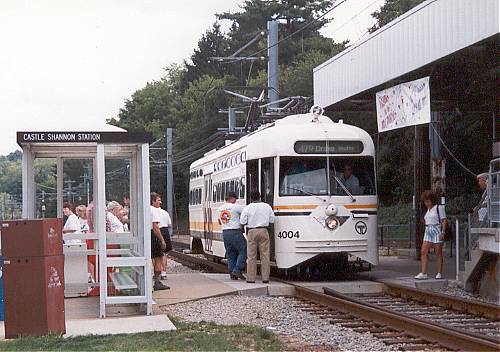|
Pittsburgh Railways OnLine |

|
In the interest of safety, PAT banished 36 PCCs from further service effective August 1. Of these, 27 were stored for parts. The sudden loss of so many cars severely compromised PAT's ability to maintain full schedules on the unrebuilt trolley lines. Of these, only Library might be able to accomodate LRVs without a total reconstruction, which PAT was not then prepared to finance.
Library's double track right-of-way was wide enough for LRVs in most places, but the devil strip between the tracks wasn't. PAT gave the line a rudimentary upgrade, renovating the track and roadbed with wider track centers to accomodate the heavy, wide LRVs. Low-level stops were still the standard on Library, and the LRVs' low-level end doors proved invaluable for this service. The big Siemens cars began running through to Library in 1988, rerouted via Beechview/Mt. Lebanon. LRV operation to Library over the precarious 5.5 mile "side-of-the-hill" Overbrook line was then practically impossible.

|
| LRV on Library's private-right-of-way, May 20, 2000. |
Prior to the light rail era, Overbrook's bucolic right of way provided a rapid ride between down- town and the outer reaches of Drake and Library. Route 42/38 was, by contrast, a local with stretches of slow, congested street running. South of Creek Clearview Loop, the right of way to Castle Shannon was single track with passing sidings, and service on that segment was later restricted to rush hours. The service had earlier been operated as a separate entity, shuttle route 38A.
Stage I initially brought more and speedier service to the route, with LRVs running through to South Hills Village all day long. The suspension of Overbrook service and the re-routing of Library cars through Beechview-Mt. Lebanon meant that all major rail services now used the formerly local corridor. Restoration of the Overbrook line -- called a longshot by some observers in 1993 -- grew increasingly desireable as rush hour delays and crowded cars prevailed in Beechview and Mt. Lebanon during the 1990s.
Eclipse of PCCs
Also during the '90s, speculation brewed about the imminent demise of the aging PCCs. By the time Overbrook was suspended, only 16 remained: 4001-4012 (4000 was re-numbered 4012 in 1986), and four spruced-up 1700s (1713/37/45/65). These were relegated to the diminutive Drake Shuttle, while dead cars rusted out their days on the back tracks at South Hills Village yard.

|
| PCC 1706 and sisters at South Hills Village, May 1996. |

|
| PCC 4004 stops at Castle Shannon on the last day of PCC service, Sept. 4, 1999. |
An era had ended. But the future of light rail in Pittsburgh was about to take a turn for the better.